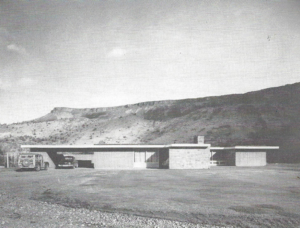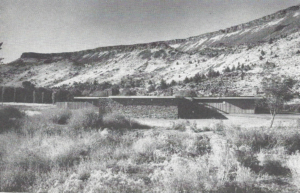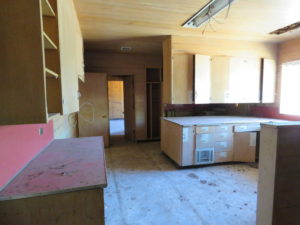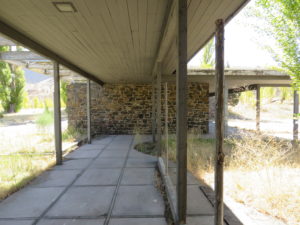
The Robert and Charles Wilson Homes, constructed along the banks of the Deschutes River, are significant for two reasons: their mid-century architectural pedigree, and the little-known role played by the Confederated Tribes of Warm Springs Reservation of Oregon (CTWSRO) in Central Oregon’s lumber industry.
Designed in the 1940s by world-renowned architect, Pietro Belluschi, the Wilson homes are his only example of multiple dwellings on a single site. Built as vacation homes for prominent figures in the Warm Springs lumber industry, they are outstanding examples of high-style, mid-century modern architecture. For the Tribes, however, they reflect a cultural struggle over ownership of the land and the timber industry jobs essential to their economic well being.
 The Wilson houses once embodied post-WWII American culture due to their inception as vacation homes for an affluent family that found success in the lumber industry. When constructed, the property was the epitome of the “American Dream,” built at the expense of the Tribes’ economy. The CTWSRO’s reclamation of the Wilson property has redefined the resources’ significance, allowing for the potential to convey the story of the CTWSRO’s understated presence in the lumber business and eventual development of Warm Springs Forest Products Industries (WSFPI).
The Wilson houses once embodied post-WWII American culture due to their inception as vacation homes for an affluent family that found success in the lumber industry. When constructed, the property was the epitome of the “American Dream,” built at the expense of the Tribes’ economy. The CTWSRO’s reclamation of the Wilson property has redefined the resources’ significance, allowing for the potential to convey the story of the CTWSRO’s understated presence in the lumber business and eventual development of Warm Springs Forest Products Industries (WSFPI).
 As such, rehabilitation of the Wilson homes and the implementation of a preservation program will foster CTWSRO’s potential to convey tribal history and strengthen future awareness of the tribal nation. In addition, the Tribes’ reclamation of this property provides opportunity to redefine the narrative of WSFPI with emphasis placed on the efforts made by the CTWSRO to regain control of their economy by adapting resources that others developed on their Reservation, even after the closure of the mill.
As such, rehabilitation of the Wilson homes and the implementation of a preservation program will foster CTWSRO’s potential to convey tribal history and strengthen future awareness of the tribal nation. In addition, the Tribes’ reclamation of this property provides opportunity to redefine the narrative of WSFPI with emphasis placed on the efforts made by the CTWSRO to regain control of their economy by adapting resources that others developed on their Reservation, even after the closure of the mill.
Duke Properties Corporation, who owned the Wilson homes for 30 years, vacated the property in 1995 after the Confederated Tribes of Warm Springs purchased the property. Both houses are in poor condition, but the larger Robert Wilson house has badly deteriorated, sitting without a tenant for 23 years. Interiors of the properties remain unchanged since the homes were first built and include original appliances and millwork.
Though understandably focused on more pressing Tribal issues, numerous preservation efforts have been made since the Tribes’ purchased the property. These efforts have included site tours to raise public awareness, site surveys, condition assessments, and maintenance attempts by Tribal staff and tenants. At the rate of deterioration, however, the threat of total loss of both homes is imminent without outside support and investment. The Tribes are exploring the potential for the properties to serve as a recreation destination to provide much-needed income.
 The proposed project is a two-part preservation strategy that involves the immediate stabilization of the Robert and Charles Wilson houses and development of a long-term adaptive reuse plan for the property. The stabilization of the homes will support the implementation of a revenue-generating preservation plan for the property that will fund maintenance of the structures and other economic projects on the Reservation in the future.
The proposed project is a two-part preservation strategy that involves the immediate stabilization of the Robert and Charles Wilson houses and development of a long-term adaptive reuse plan for the property. The stabilization of the homes will support the implementation of a revenue-generating preservation plan for the property that will fund maintenance of the structures and other economic projects on the Reservation in the future.
Project success will be measured in the opportunity created for tribal members to foster awareness of CTWSRO history in the area. The Tribes’ efforts to rehabilitate the Wilson property have begun to garner publicity and will hopefully build a support network of interested parties. The Tribes also expect the Wilson property rehabilitation project and preservation plan to serve as an essential economic driver that will help offset the loss of 146 jobs from the 2018 closure of the Kah-Nee-Ta Resort. The proposed project would help to build a gateway entrance to the Reservation, greatly improving the marketability of the area. Success of the project will be measured in the rental income generated by the Wilson property, and its potential to finance future maintenance of the structures and other economic projects on the Reservation.
 Restore Oregon, in conjunction with PMA Architects and a multitude of local stakeholders, will work to assist the Confederated Tribes of Warm Springs to conduct emergency stabilization and carrying out an adaptive reuse plan for these extraordinary homes. Saving this endangered place will recognize the Tribes’ history and role in Oregon’s lumber industry, and promote future awareness of tribal culture while developing their tourism industry.
Restore Oregon, in conjunction with PMA Architects and a multitude of local stakeholders, will work to assist the Confederated Tribes of Warm Springs to conduct emergency stabilization and carrying out an adaptive reuse plan for these extraordinary homes. Saving this endangered place will recognize the Tribes’ history and role in Oregon’s lumber industry, and promote future awareness of tribal culture while developing their tourism industry.
Join Restore Oregon today to help support this effort or contact Preservation Programs Manager, Katelyn Weber, at katelyn@restoreoregon.org to find out how you can help.

